The Woori Bank Museum is a numismatics museum in Seoul, South Korea.

The economy of South Korea is a highly developed mixed economy. By nominal GDP, the economy was worth ₩2.24 quadrillion. It has the 4th largest economy in Asia and the 14th largest in the world as of 2024. South Korea is notable for its rapid economic development from an underdeveloped nation to a developed, high-income country in a few generations. This economic growth has been described as the Miracle on the Han River, which has allowed it to join the OECD and the G20. It is included in the group of Next Eleven countries as having the potential to play a dominant role in the global economy by the middle of the 21st century. Among OECD members, South Korea has a highly efficient and strong social security system; social expenditure stood at roughly 15.5% of GDP. South Korea spends around 4.93% of GDP on advance research and development across various sectors of the economy.

Busan, officially Busan Metropolitan City, is South Korea's second most populous city after Seoul, with a population of over 3.3 million inhabitants as of 2024. Formerly romanized as Pusan, it is the economic, cultural and educational center of southeastern South Korea, with its port being South Korea's busiest and the sixth-busiest in the world. The surrounding "Southeastern Maritime Industrial Region" is South Korea's largest industrial area. The large volumes of port traffic and urban population in excess of 1 million make Busan a Large-Port metropolis using the Southampton System of Port-City classification. As of 2019, Busan Port is the primary port in Korea and the world's sixth-largest container port.
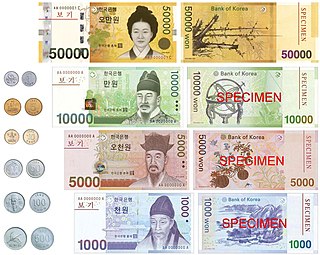
The South Korean won is the official currency of South Korea. A single won is divided into 100 jeon, the monetary subunit. The jeon is no longer used for everyday transactions, and it appears only in foreign exchange rates. The currency is issued by the Bank of Korea, based in the capital city of Seoul.

Panmunjom was a village just north of the de facto border between North Korea and South Korea, where the 1953 Korean Armistice Agreement that ended the Korean War was signed. It was located in what is now Paju, Gyeonggi Province, South Korea and Panmun-guyok, Kaesong, North Korea. The building where the armistice was signed still stands.

South Gyeongsang Province is a province in the southeast of South Korea. The provincial capital is at Changwon. It is adjacent to the major metropolitan center and port of Busan. The UNESCO World Heritage Site Haeinsa, a Buddhist temple that houses the Tripitaka Koreana and tourist attraction, is located in this province. Automobile and petrochemical factories are largely concentrated along the southern part of the province, extending from Ulsan through Busan, Changwon, and Jinju.

Gyeonggi-do is the most populous province in South Korea.
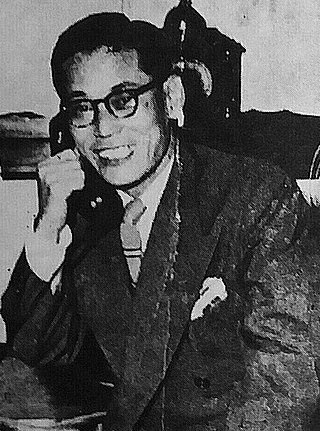
Lee Byung-chul was a South Korean businessman who founded the Samsung Group, the country's largest chaebol (conglomerate). Lee founded Samsung in 1938, at the age of 28. He is recognized as the most successful businessman in South Korea's history.
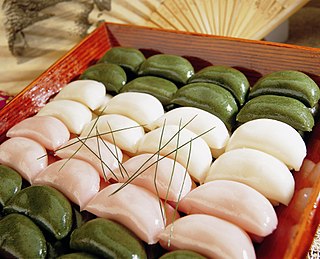
Chuseok, also known as Hangawi, is a major mid-autumn harvest festival and a three-day holiday in South Korea celebrated on the 15th day of the 8th month of the lunisolar calendar on the full moon. In North Korea, they only celebrate for the day of chuseok. Like many other harvest festivals around the world, it is held around the autumn equinox, i.e. at the very end of summer or in early autumn. It is the biggest traditional holiday in South Korea.
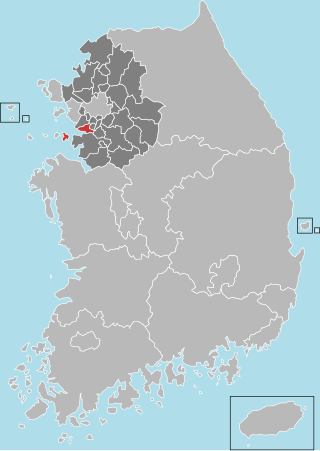
Ansan is a city in Gyeonggi Province, South Korea. It lies southwest of Seoul and is part of the Seoul National Capital Area. It is connected to Seoul by rail via Seoul Subway Line 4. It is situated on the Yellow Sea coast and some islands lie within its jurisdiction. The largest and best-known of these is Daebu Island.

Goyang is a city in Gyeonggi Province in the north of South Korea. It is part of the Seoul Capital Area, making Goyang one of Seoul's satellite cities. It is one of the largest cities in the Seoul Capital Area, with a population of just over 1 million. Ilsan, a planned city, is located in the Ilsandong-gu and Ilsanseo-gu districts of Goyang. It also includes Deogyang-gu which is closer to Seoul.

The Bank of Korea is the central bank of South Korea and issuer of South Korean won. It was established on 12 June 1950 in Seoul, South Korea.

Ewha Womans University is a private women's research university in Seoul, South Korea. It was originally founded as Ewha Haktang on May 31, 1886, by a missionary Mary F. Scranton. Currently, Ewha Womans University is one of the world's largest female educational institutes and one of the most prestigious universities in South Korea. Ewha Womans University has produced numerous South Korean women leaders, including politicians, CEOs, and legal professionals.

Tourism in South Korea and its industry caters to both foreign and domestic tourists. In 2019, 17.5 million foreign tourists visited South Korea, making it the 20th most visited country in the world. Most non-Korean tourists come from East Asia and North America, such as Taiwan and the United States. The popularity of Korean popular culture, often known as the "Korean Wave", in countries around the world has significantly increased tourist arrivals.

Shimonoseki is a city located in Yamaguchi Prefecture, Japan. As of 30 June 2023, the city had an estimated population of 248,193 in 128762 households and a population density of 350 persons per km2. The total area of the city is 716.18 square kilometres (276.52 sq mi). It is the largest city in Yamaguchi Prefecture and the fifth-largest city in the Chūgoku region in terms of population. It is nicknamed the "Fugu Capital" for the locally caught pufferfish, and is the largest harvester of the pufferfish in Japan.
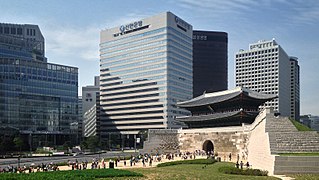
Jung District is one of the 25 districts of Seoul, South Korea.

Bank of Korea Money Museum, is an economics and numismatics museum in Seoul founded by the Bank of Korea in 2001. Its address is 39, Namdaemunno, Jung-gu, Seoul.
The Chohong Museum of Finance is a numismatics museum in Seoul, South Korea. It was created in 1997 by the Chohung Bank, which called itself the oldest bank in Korea. The museum's collections were acquired by Shinhan Bank, which renamed the museum the Korea Financial History Museum. "The Museum of Korean Financial History collects, preserves and exhibits historic materials of Shinhan. Bank and, on a broader level, Korean financial ..."
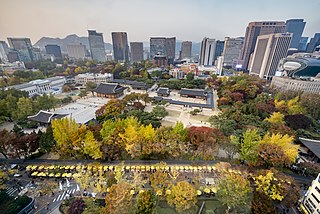
Seoul, officially Seoul Special City, is the capital and largest city of South Korea. The broader Seoul Capital Area, encompassing Gyeonggi province and Incheon Metropolitan City, emerged as the world's sixth largest metropolitan economy in 2022, trailing behind Paris, San Francisco, Los Angeles, Tokyo, and New York, and hosts more than half of South Korea's population. Although Seoul's population peaked at slightly over 10 million, it has gradually decreased since 2014, standing at approximately 9.97 million residents as of 2020. Seoul is the seat of the South Korean government.
Kakao Corporation is a South Korean Internet conglomerate headquartered in Jeju City. It was formed through the merger of Daum Communications and the original Kakao Inc in 2010. The company was renamed Daum Kakao in 2014. In 2015 it was rebranded once more, reverting simply to Kakao.